
Dakota County is the third-most populous county in the U.S. state of Minnesota, located in the east central portion of the state. As of the 2020 census, the population was 439,882. The population of Dakota County was estimated to be 443,341 in 2022. The county seat is Hastings. Dakota County is named for the Dakota Sioux tribal bands who inhabited the area. The name is recorded as "Dahkotah" in the United States Census records until 1851. Dakota County is included in the Minneapolis–St. Paul–Bloomington, MN–WI Metropolitan Statistical Area, the sixteenth largest metropolitan area in the United States with about 3.64 million residents. The largest city in Dakota County is the city of Lakeville, the eleventh-largest city in Minnesota and sixth-largest Twin Cities suburb. The county is bordered by the Minnesota and Mississippi Rivers on the north, and the state of Wisconsin on the east.

Cottage Grove is a city 10 miles (16 km) south of Saint Paul in Washington County in the State of Minnesota. It lies on the north bank of the Mississippi River, north of the confluence with the St. Croix River. Cottage Grove and nearby suburbs form the southeast portion of Minneapolis-Saint Paul, the 16th-largest metropolitan area in the United States, with about 3.69 million residents. Its population was 38,839 at the 2020 census.
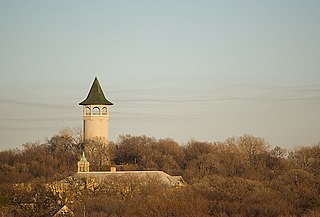
Prospect Park is a historic neighborhood within the University community of the U.S. city of Minneapolis, Minnesota. The area is bounded by the Mississippi River to the south, the City of Saint Paul, Minnesota to the east, the Burlington Northern railroad yard to the north, and the Stadium Village commercial district of the University of Minnesota to the west. The neighborhood is composed of several districts which include the East River Road area. The 1913 Prospect Park Water Tower is a landmark and neighborhood icon.
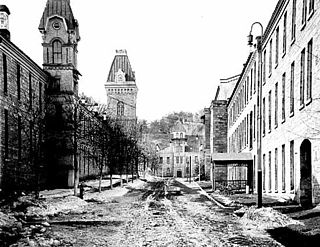
The Minnesota Territorial Prison, later the Minnesota State Prison, was a prison in Stillwater, Minnesota, United States, in operation from 1853 to 1914. Construction of the prison began in 1851, shortly after Minnesota became a territory. The prison was replaced by the Minnesota Correctional Facility – Stillwater in nearby Bayport. Most of the original prison's structures were demolished in 1936, leaving only the 1853 Warden's House and a manual labor complex that had been constructed 1884–1898. The surviving factory buildings were listed on the National Register of Historic Places in 1982 for having state-level significance in the themes of industry and social history. The historic site, long since unused, was destroyed by arson on September 3, 2002. It was formally delisted from the National Register in 2005.

The Frank B. Kellogg House is a historic house at 633 Fairmount Avenue in Saint Paul, Minnesota, United States. It is listed as a National Historic Landmark for its association with Nobel Peace Prize-winner Frank B. Kellogg, co-author of the Kellogg–Briand Pact. Kellogg Boulevard in downtown Saint Paul is also named for him. The house was designated a National Historic Landmark in 1976. It is also a contributing property to the Historic Hill District.

The Alexander Ramsey House is a historic house museum in Saint Paul, Minnesota, United States; the former residence of Alexander Ramsey, who served as the first governor of Minnesota Territory and the second governor of the state of Minnesota. It was listed on the National Register of Historic Places in 1969. It is also a contributing property to the Irvine Park Historic District.

Summit Avenue is a street in St. Paul, Minnesota, United States, known for being the longest avenue of Victorian homes in the country, having a number of historic houses, churches, synagogues, and schools. The street starts just west of downtown St. Paul and continues four and a half miles west to the Mississippi River where Saint Paul meets Minneapolis. Other cities have similar streets, such as Prairie Avenue in Chicago, Euclid Avenue in Cleveland, and Fifth Avenue in New York City. Summit Avenue is notable for having preserved its historic character and mix of buildings, as compared to these other examples. Historian Ernest R. Sandeen described Summit Avenue as "the best preserved example of the Victorian monumental residential boulevard."

Irvine Park is a neighborhood just west of downtown Saint Paul, Minnesota, United States, that contains a number of historic homes. The neighborhood was platted by John Irvine and Henry Mower Rice in 1849. At the center of the neighborhood is Irvine Park, a New England-style public square. The neighborhood is a district listed on the National Register of Historic Places and also designated by the city as a historic district.
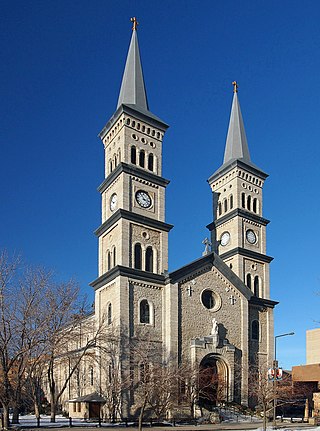
The Church of the Assumption Catholic Church was dedicated in 1874 and is the oldest existing church in Saint Paul. It is located at 51 West Seventh Street, in downtown Saint Paul. The building is listed on the National Register of Historic Places.
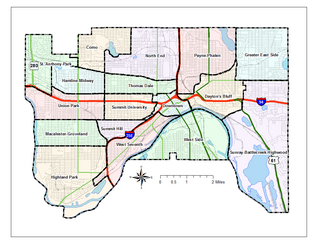
Saint Paul, Minnesota, consists of 17 officially defined city districts or neighborhoods.
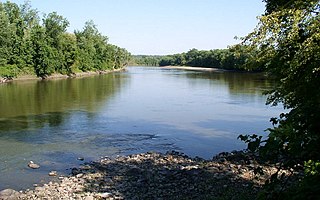
Traverse des Sioux is a historic site in the U.S. state of Minnesota. Once part of a pre-industrial trade route, it is preserved to commemorate that route, a busy river crossing on it, and a nineteenth-century settlement, trading post, and mission at that crossing place. It was a transshipment point for pelts in fur trading days, and the namesake for an important United States treaty that forced the Dakota people to cede part of their homeland and opened up much of southern Minnesota to European-American settlement.
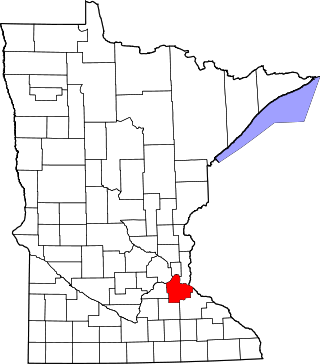
This is a list of the National Register of Historic Places listings in Dakota County, Minnesota. It is intended to be a complete list of the properties and districts on the National Register of Historic Places in Dakota County, Minnesota, United States. Dakota County is located in the southeastern part of the U.S. state of Minnesota, bounded on the northeast side by the Upper Mississippi River and on the northwest by the Minnesota River. The locations of National Register properties and districts for which the latitude and longitude coordinates are included below, may be seen in an online map.
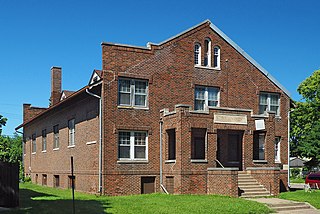
The Serbian Home is a two-story brick building, that was built in 1924 in South Saint Paul in the U.S. state of Minnesota. It was built as a community center for Serbian immigrants who worked in the meatpacking industry. It served as a museum respecting the multitude of ethnic groups who have made the city their home until 2020, when it was purchased and renovated by Serbian immigrant Aleksandar Stojmenovic to serve as an event center.

This list is of the properties and historic districts which are designated on the National Register of Historic Places or that were formerly so designated, in Hennepin County, Minnesota; there are 190 entries as of April 2023. A significant number of these properties are a result of the establishment of Fort Snelling, the development of water power at Saint Anthony Falls, and the thriving city of Minneapolis that developed around the falls. Many historic sites outside the Minneapolis city limits are associated with pioneers who established missions, farms, and schools in areas that are now suburbs in that metropolitan area.

The Benjamin Brunson House is one of the oldest houses remaining in Saint Paul, Minnesota it was built ca. 1856 in the area known as "railroad island," being surrounded by tracks. It is listed on the National Register of Historic Places.
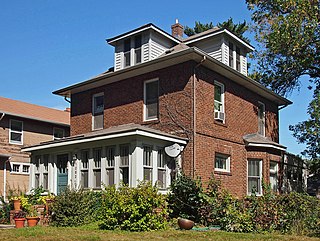
The Casiville Bullard House is a historic house in Saint Paul, Minnesota, United States. It was built from 1909 to 1910 by stonemason and bricklayer Casiville Bullard (1873–1959), one of the few known African-American skilled workers active in the building trades in early-20th-century Saint Paul. The house was listed on the National Register of Historic Places in 1997 for its local significance in the themes of black history and social history.

The St. Paul Women's City Club is a 1931 Art Deco Streamline Moderne-style Mankato limestone clubhouse in Saint Paul, Minnesota, that was designed by architect Magnus Jemne (1882-1964). The building was designed to provide a "center for organized work and for social and intellectual intercourse", and provided a dining room, assembly rooms, dressing rooms, and bedrooms for the 1000 members of the club and their guests. The building was sold to the Minnesota Museum of Art in 1972 and now houses an architectural firm. It is listed on the National Register of Historic Places.

The Snake River Fur Post is a reconstructed fur trade post on the Snake River west of Pine City, Minnesota, United States of America. The post was established in the fall of 1804 by John Sayer, a partner in the North West Company, and built by his crew of voyageurs. The site operated for several years, although its exact period of operation is unknown. It was later destroyed by fire.

The Comstock House is a historic house museum in Moorhead, Minnesota, United States. It was built for Solomon Comstock and his family from 1882 to 1883 in a mix of Queen Anne and Eastlake style. Comstock (1842–1933) was one of Moorhead's first settlers and an influential figure in business, politics, civics, and education in the growing city and state.
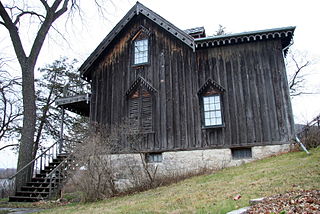
The Willard Bunnell House is a historic house museum in Homer, Minnesota, United States. The house was listed on the National Register of Historic Places in 1973 for having state-level significance in the themes of architecture, commerce, and exploration/settlement. It was nominated for being Minnesota's first permanent house south of Saint Paul, as well as for its Gothic Revival architecture and association with brothers Willard (1814–1861) and Lafayette Bunnell (1824–1903), who helped develop the area during its frontier days. It is now managed by the Winona County Historical Society.


























